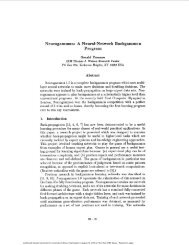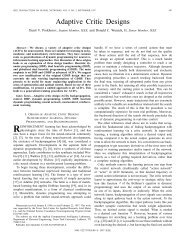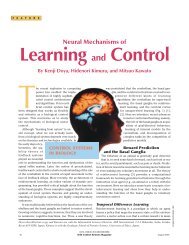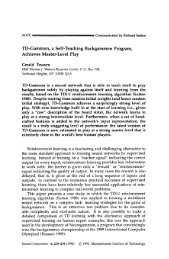Neural-Network-Based State Feedback Control of a ... - IEEE Xplore
Neural-Network-Based State Feedback Control of a ... - IEEE Xplore
Neural-Network-Based State Feedback Control of a ... - IEEE Xplore
You also want an ePaper? Increase the reach of your titles
YUMPU automatically turns print PDFs into web optimized ePapers that Google loves.
JAGANNATHAN AND HE: NN-BASED STATE FEEDBACK CONTROL OF A NONLINEAR DISCRETE-TIME SYSTEM 2075<br />
compact set , i.e., ,<br />
, and ,<br />
and , where , ,<br />
, and . Without the loss generality,<br />
we will assume , , and (to be defined later)<br />
are positive in this paper. Next, the adaptive backstepping NN<br />
control design is introduced.<br />
Step 1 (Virtual <strong>Control</strong>ler Design): Define the tracking error<br />
as<br />
Equation (5) can be rewritten after the substitution <strong>of</strong> system<br />
dynamics from (4) as<br />
(5)<br />
Equation (6) can be expressed using (11) for<br />
or, equivalently<br />
where<br />
and<br />
as<br />
(12)<br />
(13)<br />
(14)<br />
(15)<br />
By viewing as a virtual control input, a desired feedback<br />
control signal can be designed as<br />
where is a design constant selected, such that the tracking<br />
error is asymptotically stable. Assumption 1 ensures that<br />
is bounded away from zero.<br />
Because and are unknown smooth functions,<br />
the desired feedback control cannot be implemented<br />
in practice. From (7), it can be seen that the unknown part<br />
is a smooth function <strong>of</strong><br />
, , and . By utilizing NN to approximate<br />
this unknown part consisting <strong>of</strong> the ratio <strong>of</strong> two unknown<br />
smooth functions, can be expressed as [6]<br />
where<br />
denotes the constant target weights <strong>of</strong><br />
the output layer,<br />
is the weights <strong>of</strong> the hidden layer,<br />
is the nodes number <strong>of</strong> hidden layer, is the hidden layer<br />
activation function, is the approximation error,<br />
is the design constant, and the NN input is taken as<br />
. Only the hidden-layer NN weights<br />
are updated, whereas the input-layer weights are selected initially<br />
at random and held constant so that hidden-layer activation<br />
function vector forms a basis [11].<br />
Consequently, the virtual control is given as<br />
(6)<br />
(7)<br />
(8)<br />
Note that is bounded given the fact that , , and<br />
are all bounded.<br />
Step 2 (Design <strong>of</strong> the <strong>Control</strong> Input ): Write the error<br />
from (11) as<br />
(16)<br />
where is the future value <strong>of</strong> . Here this problem<br />
is solved by using a semirecurrent NN because it can be used as<br />
a one-step predictor. The term depends on state ,<br />
virtual control input , and desired trajectory .<br />
By taking the independent variables as the NN inputs,<br />
can be approximated during control input selection. From (11),<br />
can be obtained as a nonlinear function <strong>of</strong> ,<br />
where<br />
, i.e.,<br />
, where is a nonlinear mapping.<br />
Consequently, it can be approximated by the NN. Alternatively,<br />
the value <strong>of</strong><br />
can also be obtained by employing a<br />
filter [5]. In this paper, a feedforward NN with properly chosen<br />
weight tuning law rendering a semirecurrent or dynamic NN<br />
will be used to predict the future value. The first layer <strong>of</strong> the<br />
second NN using the system estimates, past value <strong>of</strong><br />
along with the desired value <strong>of</strong> the first state as inputs to an<br />
NN, generates , which in turn is used by the second<br />
layer to generate a suitable control input. On the other hand,<br />
one can use a single-layer dynamic NN to generate the future<br />
value <strong>of</strong> , which can be utilized as an input to a third<br />
control NN to generate a suitable control input. Here, these two<br />
single-layer NNs are combined into a single two-layer NN with<br />
semirecurrent architecture.<br />
Choose the desired control input and use the second NN to<br />
approximate the unknown dynamics as<br />
(9)<br />
where<br />
is the actual NN weight. Define the error<br />
in weights during estimation by<br />
(17)<br />
Define the error between and as<br />
(10)<br />
(11)<br />
where<br />
is the matrix <strong>of</strong> target weights <strong>of</strong> the<br />
output layer,<br />
is the weights <strong>of</strong> the hidden layer,<br />
is the nodes number <strong>of</strong> hidden layer, is the vector <strong>of</strong><br />
activation functions, is the approximation error, is<br />
the design constant, and the NN input is selected as . Here,









